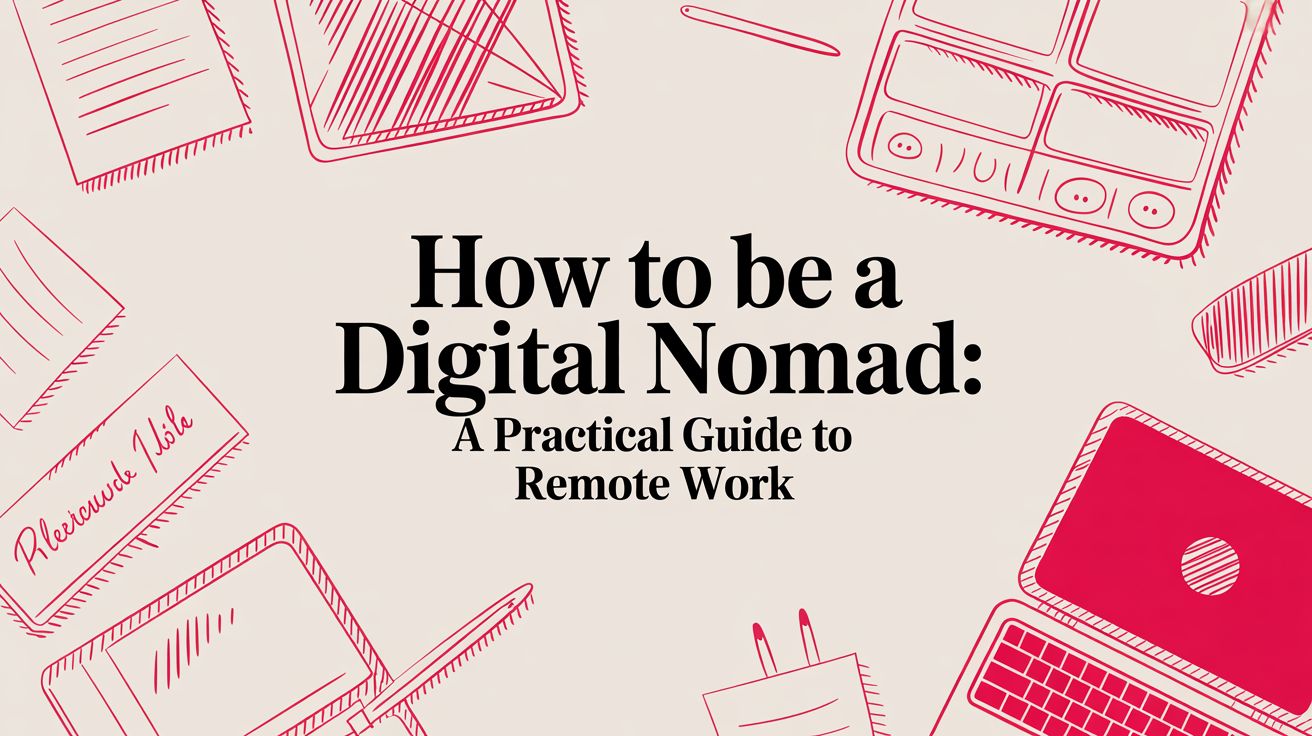A Guide to Remote Contract Work
Max
Think of remote contract work as being your own boss, but for other companies. You’re essentially running a one-person business, offering your specific skills to clients for set projects, all from wherever you choose to work. It’s the freedom of freelancing mixed with the clear goals of a defined project, offering a pretty compelling alternative to a standard 9-to-5.
Understanding the World of Remote Contract Work

Here’s a simple way to look at it. A regular remote employee is like a permanent member of a ship’s crew. They have a specific role, a steady paycheck, and benefits from the captain. A remote contractor, on the other hand, is like a seasoned navigator brought on board for one particularly treacherous part of the journey. You use your expert knowledge to guide the ship through a storm, and once you’re in clear waters, your contract is done.
That analogy really gets to the heart of it: remote contract work is project-based and temporary. You aren’t an employee; you’re a skilled service provider hired to solve a specific problem or complete a particular task.
The Contractor and Employee Divide
The line between a contractor and a remote employee is a big one, and it affects way more than just how you get paid. It changes everything from your tax situation to how much control you have over your day. When you’re a contractor, you’re in a business-to-business relationship, not an employer-to-employee one. This is a crucial distinction.
To really see the difference, let’s put the two side-by-side. The table below breaks down the key distinctions you’ll encounter.
| Aspect | Remote Contractor | Remote Employee |
|---|---|---|
| Employment Status | Self-employed (your own boss) | Company employee |
| Tax Forms | Receives a 1099-NEC | Receives a W-2 |
| Tax Obligations | Pays own income & self-employment taxes | Taxes withheld from each paycheck |
| Benefits | No company benefits (health, 401k, PTO) | Receives company benefits package |
| Tools & Equipment | Provides their own laptop, software, etc. | Company typically provides equipment |
| Autonomy | High degree of control over work methods | Follows company processes and direction |
| Work Security | Based on project duration; less stable | More stable, ongoing employment |
As you can see, the trade-offs are pretty clear. The contractor path gives you more freedom but also puts a lot more on your plate.
A crucial element of remote contract work is the shift in mindset. You are not just doing a job; you are running a business of one. This involves managing finances, marketing your services, and planning for the future independently.
This structure is what gives you so much flexibility, but it also demands a huge amount of personal responsibility. Getting your head around this fundamental divide is the first step to figuring out if a career in remote contract work is right for you. Now that you understand the key differences, let’s get into the good, the bad, and the ugly by exploring the pros and cons.
Weighing the Freedom and Risks of a Contractor Lifestyle

Choosing to become a remote contractor is a bit like deciding to captain your own sailboat instead of booking a ticket on a cruise ship. The cruise is predictable, safe, and all-inclusive. The sailboat? That’s pure freedom. You chart your own course and feel the wind in your sails, but you’re also the one navigating the storms and patching the leaks.
The contractor lifestyle offers an incredible level of autonomy. You decide when the workday starts, where you set up shop, and which projects actually get you excited. For many professionals, this level of control and the chance to achieve a genuine work-life balance is the biggest draw.
But with that freedom comes a hefty dose of personal responsibility. The comfort of a steady, bi-weekly paycheck disappears, replaced by the natural ebb and flow of project-based income. This isn’t just a small shift; it requires a completely different way of thinking about your finances. Building a solid safety net isn’t just a good idea—it’s your lifeline.
The Allure of Autonomy and Higher Rates
Let’s talk money. One of the most attractive parts of going contract is the potential for a higher income. Contractors almost always command higher hourly rates than their salaried peers. Why? Because clients are paying for specialized expertise without the overhead of benefits, payroll taxes, or paid vacation.
That higher rate is your direct compensation for the risks you’re taking on. Think of it as a premium for your skills and your willingness to be your own boss. You get to negotiate your worth for every single project, which means your income can scale directly with your expertise and reputation.
Beyond the paycheck, the sheer variety of work can be incredibly energizing. One month you could be diving into the fintech world, the next you’re helping a non-profit. This constant change keeps your skills sharp and your professional life interesting, steering you clear of the career stagnation that can creep into a long-term role.
Confronting the Challenges Head-On
While the perks are compelling, the challenges are just as real. The biggest hurdle for most contractors is the inconsistent income. Projects end. Sometimes there are gaps before the next one starts, creating a stressful “feast or famine” cycle if you’re not prepared.
This instability is amplified because you are your own safety net. All of it.
- Benefits Are Your Job: You’re in charge of finding and funding your own health insurance, retirement plans (like a SEP IRA or Solo 401(k)), and any disability or life insurance you might need.
- Taxes Are on You: You’re responsible for calculating and paying self-employment taxes—which cover Social Security and Medicare—directly to the government, usually through quarterly estimated payments.
- No Paid Time Off: Every vacation day, sick day, and holiday is unpaid. If you don’t work, you don’t earn. This requires a new level of planning for any time you want to take off.
More and more people are navigating these trade-offs. Recent data shows that roughly 22.8% of U.S. employees, or about 36.07 million workers, worked remotely at least some of the time. This massive shift proves that the modern workforce is changing, and contract work is a huge piece of that puzzle. You can dig deeper into remote work trends to see how the landscape is evolving.
The contractor lifestyle demands a CEO mindset. You are not just a writer, developer, or marketer; you are the head of sales, finance, and operations for your own one-person company.
Ultimately, deciding if remote contract work is right for you comes down to a gut check. Are you a self-starter who thrives on independence? Are you ready to manage the business side of things? If you can embrace the risks and build systems to handle them, the freedom and professional growth can be more rewarding than you can imagine.
Mastering Your Finances and Legal Obligations

Making the leap to remote contract work is a bit like becoming the CEO of “You, Inc.” All of a sudden, you’re not just the talent—you’re the finance department, legal team, and head of admin, all rolled into one. This isn’t something you can just wing; it requires a hands-on approach to your money and a clear understanding of your obligations.
Honestly, ignoring this side of the business is one of the fastest ways to get into hot water. From picking apart contracts to managing your own taxes, getting a handle on these responsibilities is non-negotiable if you want to build a sustainable career.
Decoding Your Independent Contractor Agreement
Before you type a single word or write a line of code, you’ll sign an independent contractor agreement. Think of this document as the official rulebook for your relationship with a client. It’s so important to read every single line, because it’s there to protect both of you.
These agreements can look pretty intimidating with all the legal jargon, but they usually boil down to a few key sections. Keep a close eye on these parts to make sure the terms are fair and crystal clear.
- Scope of Work (SOW): This is where the project is defined. It should spell out exactly what you’ll deliver, including specific tasks and deadlines. A vague SOW is a recipe for “scope creep,” where you find yourself doing way more work than you were actually paid for.
- Payment Terms: Look for the agreed-upon rate (is it hourly or per project?), the invoicing schedule (weekly, monthly?), and when you’ll get paid (e.g., Net 30, which means 30 days after they get your invoice). Make sure it’s obvious how and where to send your invoices.
- Intellectual Property (IP): This clause clears up who owns the work you create. Typically, the client owns the final product after you’ve been paid in full. This is pretty standard stuff.
- Termination Clause: This part explains how you or the client can end the contract. It should outline how much notice is required and if there are any specific conditions for calling it quits early.
Your contract is your primary safety net. It clarifies expectations, defines the boundaries of the professional relationship, and provides a legal framework if disputes arise. Never start a project without a signed agreement in place.
Navigating Your Tax Responsibilities
As a contractor, say goodbye to automatic tax withholding. You’re now in charge of calculating and paying your own taxes to the government. This is probably the biggest financial mind-shift you’ll make when you start remote contract work.
The big one you need to know about is the self-employment tax. This covers your Social Security and Medicare contributions. When you were an employee, your boss split this with you. Now, you’re on the hook for both halves, which comes out to 15.3% on the first $168,600 of your earnings (for 2024), and 2.9% on anything above that.
Since nothing is being taken out of your paychecks, you have to pay estimated taxes to the IRS throughout the year, usually on a quarterly basis. If you don’t, you could be hit with some nasty penalties when tax season rolls around. For a complete walkthrough, check out our guide on https://remotefirstjobs.com/blog/remote-work-taxes for a deeper look into these obligations.
Choosing a Simple Business Structure
To operate as a legitimate business, you’ll need a legal structure. For most contractors just starting out, it usually comes down to two simple options. Each has different implications for your personal liability and how much paperwork you’ll be dealing with.
1. Sole Proprietorship This is the default, no-fuss option for independent contractors. You don’t need to file any special paperwork to create it—you and your business are considered one and the same in the eyes of the law.
- Pros: It’s dead simple and costs nothing to set up. You just report your business income on your personal tax return.
- Cons: There’s zero legal separation between your personal and business finances. If your business gets sued, your personal assets—like your car or house—could be on the line.
2. Limited Liability Company (LLC) Forming an LLC creates a legal wall between you and your business. It’s a very popular choice for contractors who want an extra layer of protection.
- Pros: It shields your personal assets from business debts and lawsuits. It can also make you look a bit more established and professional to clients.
- Cons: It costs money to file with your state and requires more administrative work, like keeping a separate business bank account.
Picking the right structure is a foundational step in protecting yourself. And as you start sending invoices and getting paid, you might also want to look into potential savings in invoicing and payment fees for freelancers to boost your take-home pay. A successful career in remote contract work starts with building a solid financial and legal foundation from day one.
How To Find and Win High-Value Remote Contracts

Landing a great remote contract isn’t about casting a wide net and hoping for the best. It’s more like spear-fishing—it takes focus, a smart strategy, and knowing exactly where the best opportunities are hiding. If you’re only looking in one place, you’re setting yourself up for a feast-or-famine cycle. A multi-channel approach is the only way to build a steady stream of quality work.
This means you have to think beyond the big-name freelance platforms. While sites like Upwork or Toptal can be solid starting points, the real high-value contracts are often found through your professional network and by being proactive. The ultimate goal is to build a system where opportunities find you, instead of you constantly hunting for the next gig.
Optimizing Your Professional Footprint
Think of your online presence as your digital storefront. Long before a client reads your proposal, they’re going to Google you. A strong, consistent professional brand across a few key platforms builds instant trust and makes you look like the real deal.
Let’s start with the basics. Your portfolio shouldn’t just be a gallery of pretty pictures; it needs to be a collection of success stories. Don’t just say, “I designed a website.” Instead, frame it with results: “I redesigned a client’s e-commerce site, which led to a 15% increase in conversions and a 20% drop in bounce rate.” Always use concrete numbers to show the real-world value you bring to the table.
Your LinkedIn profile is another powerhouse tool for landing clients. Tweak your headline to be crystal clear about what you do and who you do it for (e.g., “Freelance Python Developer for SaaS Startups”). Get active on the platform by sharing useful insights, commenting on posts from industry leaders, and connecting with potential clients in your niche.
A powerful portfolio answers a client’s unspoken question: “Can this person solve my specific problem?” Focus on demonstrating results and return on investment, not just listing tasks you’ve completed.
The competition for remote work is no joke. Even though remote and hybrid roles attract 60% of all job applications, they only make up about 20% of the jobs available. This mismatch shows just how important it is to stand out from the crowd.
Mastering Freelance Platforms and Beyond
Freelance marketplaces are a fantastic way to get your feet wet and build a solid reputation, but you need a game plan. Don’t just create a profile and wait. You have to be an active player.
- Tailor Every Single Proposal: Clients can spot a generic, copy-pasted proposal from a mile away—and they’ll ignore it. Read the job post carefully, address the client’s specific problems, and explain exactly how your skills are the solution.
- Invest in Your Profile: A complete, well-written profile with a professional photo and a detailed work history is non-negotiable. Sprinkle in keywords relevant to your skills so you show up in more searches.
- Leverage Social Proof: Gently nudge happy clients to leave you a positive review. On these platforms, strong ratings and glowing testimonials are pure gold.
While platforms are great, don’t let them be your only source of leads. The most successful contractors have several channels for finding clients. If you’re looking for more ideas, our article on https://remotefirstjobs.com/blog/how-to-find-remote-work dives deeper into different methods. For contractors ready to level up, mastering strategies for acquiring new clients is the key to building a truly sustainable business.
When you’re ready to explore these platforms, knowing where to start can save you a ton of time.
Top Platforms for Finding Remote Contract Work
Here’s a quick rundown of some popular platforms, who they’re best for, and the kind of work you can expect to find.
| Platform | Best For | Average Project Size |
|---|---|---|
| Upwork | A wide range of freelancers, from beginners to experts. | Small to medium ($100 - $5,000) |
| Fiverr | Creatives and professionals offering “gig-based” services. | Small ($5 - $1,000) |
| Toptal | Top 3% of talent in tech, design, and finance. | Large, long-term ($5,000+) |
| FlexJobs | Professionals seeking vetted, flexible, and remote roles. | Varies (Subscription-based) |
| Contra | Commission-free platform for independent professionals, especially Gen Z. | Small to medium ($500 - $10,000) |
Each platform has its own vibe and community, so it’s worth exploring a couple to see which one feels like the right fit for your skills and goals.
The Power of Proactive Outreach
Sitting around and waiting for clients to discover you is a slow, unpredictable path. The real game-changer is getting proactive—identifying companies you’d love to work with and reaching out to them directly. This immediately positions you as a problem-solver, not just another applicant in a long queue.
Start by making a “dream client” list of 20-30 companies that align with your skills and what you care about. Do a little digging to understand their business, what challenges they might be facing, and who the key decision-makers are. You can usually find a Head of Marketing or Director of Engineering on LinkedIn.
Then, craft a short, personalized email or LinkedIn message. Ditch the generic sales pitch. Make it all about them:
- Lead with Value: Start by mentioning a recent project of theirs you admired or offer one specific, helpful insight about their website or product.
- Connect to Their Needs: Briefly explain how your skills could help them hit a specific goal, like improving their user onboarding or streamlining their content.
- End with a Clear Ask: Suggest a quick, 15-minute chat to talk more about their needs. Make it super easy for them to say “yes.”
This hands-on approach to finding remote contract work takes more effort upfront, but it pays off with higher-quality clients and much more interesting projects. It flips the script, putting you in the driver’s seat of your career and helping you build a freelance business that doesn’t just survive, but thrives.
Developing Habits for Long-Term Contractor Success
Making it as a remote contractor isn’t about one big break. It’s about the small, consistent habits you build day after day. These habits become the system that keeps your productivity high, your clients happy, and your business growing. Without them, the freedom you wanted can quickly turn into chaos.
The first major hurdle is always managing your own time. When you’re the boss, nobody is looking over your shoulder. That’s why proven time management techniques are non-negotiable for staying focused and hitting your deadlines.
Mastering Your Schedule and Focus
Think of your workday not as one long slog, but as a series of intentional sprints. A couple of popular methods are fantastic for structuring your day to hit peak performance and sidestep that dreaded burnout.
- Time Blocking: This is exactly what it sounds like—you schedule everything. From deep work on a client project to taking a lunch break, every part of your day gets a specific block on your calendar. It creates a clear roadmap, cuts down on decision fatigue, and ensures the important stuff actually gets done.
- The Pomodoro Technique: This one’s a classic for a reason. You work in focused 25-minute bursts, separated by short breaks. It’s a brilliant way to tackle massive projects without feeling overwhelmed and keeps your concentration sharp.
To really get these methods working for you, check out some of the excellent remote work productivity tools available. They’re designed to help you implement these techniques and keep your workflow smooth.
The Art of Proactive Communication
When you’re remote, you can’t rely on body language or a quick chat by the water cooler to build a relationship. Your communication has to be deliberate, clear, and proactive. It’s truly the foundation of trust and managing client expectations.
Don’t ever make a client chase you for an update. Send regular progress reports, give them a heads-up about any potential roadblocks you see coming, and never, ever be afraid to ask for clarification. Over-communicating is always better than leaving them guessing.
Crystal-clear communication is your best tool for preventing scope creep and misunderstandings. A simple weekly summary email can build immense confidence and reinforce your value as a reliable professional partner.
Nailing these communication habits from day one sets a professional tone for the entire project. This approach smooths out potential friction and helps build the kind of long-term client relationships that lead to more work and great referrals.
Pricing Your Services and Negotiating with Confidence
Figuring out how to value your skills is easily one of the trickiest parts of remote contract work. Setting your rates isn’t just about picking a number out of thin air; it’s a strategic move that reflects your expertise, market demand, and the real value you bring to the table.
Start by doing some homework. See what other contractors with your level of experience are charging. Then, calculate a rate that covers your target income plus all your business expenses, taxes, and benefits. As your skills grow, so should your rates. When you can clearly show a client the return on their investment, you’ll have all the leverage you need to negotiate with confidence.
Committing to Continuous Learning
The skills that are hot today might be old news tomorrow. The most successful remote contractors are lifelong learners, always adding new skills to their arsenal. Staying current isn’t just a good idea—it’s essential for your long-term survival.
This is especially true as talent markets become more global. The tech sector, for instance, has seen massive shifts. More than 70% of U.S. tech firms are now working with nearshore talent in places like Latin America to find specialized skills at a competitive price. This trend really underscores how remote work is changing the game globally.
Staying sharp ensures you remain a top-tier choice in a very competitive field. If you need a little help keeping that fire lit, check out our guide on https://remotefirstjobs.com/blog/how-to-stay-motivated-working-from-home for some great tips.
The Future of Remote Contract Work
The world of remote contract work isn’t standing still—far from it. It’s always changing, and if you want to stay ahead of the curve, you’ve got to keep an eye on what’s coming next. This isn’t just about staying relevant; it’s about making sure your skills and your business are always in demand.
The biggest shift we’re seeing? The rise of AI and automation. Instead of looking at these tools as a threat, the smartest contractors are treating them like powerful assistants. Think about it: AI can handle the tedious stuff like drafting proposals, sending invoices, or even doing that initial client research. That frees you up to pour your energy into the high-value, strategic work that really needs a human brain. The focus is shifting from repetitive tasks to creativity and critical thinking.
Adapting to a Global and Specialized Market
As more companies get comfortable hiring talent from anywhere on the planet, the talent pool is getting wider and deeper. This is a massive opportunity, but it also means more competition. So, how do you stand out? You stop being a jack-of-all-trades and become a true specialist. Deep, focused expertise in a specific niche is what will let you command higher rates and attract the best clients.
Ultimately, thriving in this new landscape comes down to your willingness to adapt. The fundamentals haven’t changed—you still need to deliver incredible value, run your business like a CEO, and communicate clearly. But the tools you use and what the market demands will keep evolving. Treating lifelong learning as a core business strategy isn’t just a good idea; it’s essential for survival.
The future of remote contract work belongs to those who are agile. Your ability to adapt, specialize, and leverage new technologies will directly determine your long-term success and resilience in an increasingly connected world.
What all this change really offers is an incredible amount of control over your own career path. By staying informed and ready to pivot, you can build a stable, fulfilling career entirely on your own terms. For anyone just starting out, a great first step is getting a solid grasp on the foundational remote work benefits that make this career so compelling.
Frequently Asked Questions About Remote Contracting
Diving into remote contracting can feel like charting new territory, and it’s totally normal to have questions pop up along the way. Think of this as your field guide, with straight-up answers to the stuff that new and aspiring contractors ask the most.
How Do I Calculate My Hourly Rate?
Figuring out what to charge is one of the first big hurdles. Don’t just pull a number out of thin air; there’s a simple formula that will get you a solid starting point.
First, decide on your ideal annual salary. Now, tack on about 30% to that number. Why? Because you’re the boss now, and that extra cushion is crucial for covering things like self-employment taxes, health insurance, software subscriptions, and all the other costs of doing business.
Got that total? Great. Now, just divide it by 2,080. That’s roughly how many hours are in a standard work year (40 hours a week x 52 weeks). The result is your baseline hourly rate. From there, you can tweak it based on your years of experience, how much demand there is for your skills, and the unique value you bring to the table.
What Is The Best Way To Handle Benefits?
Welcome to the CEO seat of your own benefits department. As a contractor, you’re in charge of your health insurance and retirement savings, so you’ve got to be proactive.
- Health Insurance: You can check out plans on your country’s public health insurance marketplace (like Healthcare.gov in the U.S.). Another smart move is to look into health plans offered through professional groups or freelancer unions—they often have access to group rates you can’t get on your own.
- Retirement Savings: To build your nest egg, you’ll want to open a retirement account specifically for self-employed folks. A SEP IRA or a Solo 401(k) are fantastic options. They let you contribute way more than a traditional IRA and come with some pretty sweet tax advantages.
Taking ownership of your benefits isn’t just an option; it’s a non-negotiable part of making remote contract work a sustainable career. It takes a bit of planning, but it gives you a safety net for your health and a solid game plan for your financial future.
Can I Work For Companies In Other Countries?
You bet! This is honestly one of the coolest parts of remote contract work. The ability to team up with clients across the globe blows the doors wide open on potential projects and can lead to some incredibly rewarding experiences.
Of course, international work adds a few extra layers to think about. Your contract needs to be crystal clear about the payment currency and how you’ll get paid to avoid any mix-ups. Tax laws can also get complicated fast when you’re dealing with different countries, so it’s a smart move to chat with a tax pro who knows their way around international agreements. It’s a small investment that can save you from big headaches and surprise bills later.
Ready to find your next great project? Remote First Jobs has thousands of vetted, spam-free listings from companies that are actively looking for remote talent just like you. Find your perfect role today!


